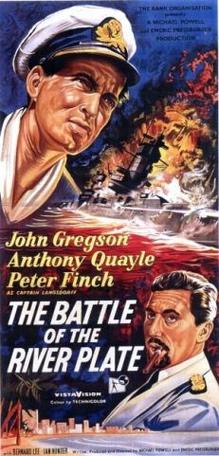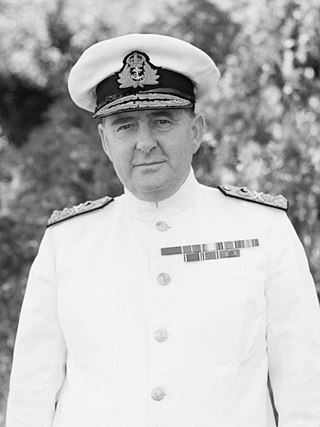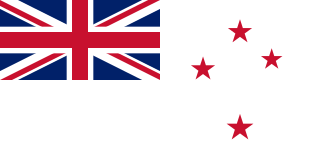
The Battle of the River Plate was fought in the South Atlantic on 13 December 1939 as the first naval battle of the Second World War. The Kriegsmarine heavy cruiser Admiral Graf Spee, commanded by Captain Hans Langsdorff, engaged a Royal Navy squadron, commanded by Commodore Henry Harwood, comprising the light cruisers HMS Ajax, HMS Achilles and the heavy cruiser HMS Exeter.

The Battle of the River Plate is a 1956 British war film in Technicolor and VistaVision by the writer-director-producer team of Michael Powell and Emeric Pressburger. The film stars John Gregson, Anthony Quayle, Bernard Lee and Peter Finch. It was distributed worldwide by Rank Film Distributors Ltd.

Hans Wilhelm Langsdorff was a German naval officer, most famous for his command of the German pocket battleship Admiral Graf Spee before and during the Battle of the River Plate off the coast of Uruguay in 1939. After the Panzerschiff was unable to escape a pursuing squadron of Royal Navy ships, Langsdorff scuttled his ship. Three days later he died by suicide in his hotel room in Buenos Aires, Argentina.

The Royal New Zealand Navy is the maritime arm of the New Zealand Defence Force. The fleet currently consists of nine ships. The Navy had its origins in the Naval Defence Act 1913, and the subsequent purchase of the cruiser HMS Philomel, which by 1921 had been moored in Auckland as a training ship. A slow buildup occurred during the interwar period, and then perhaps the infant Navy's most notable event occurred when HMS Achilles fought alongside two other Royal Navy cruisers at the Battle of the River Plate against the German ship, Graf Spee, in December 1939.

The York class was the second and final class of heavy cruisers built for the Royal Navy under the terms of the 1922 Washington Naval Treaty. They were essentially a reduced version of the preceding County class, scaled down to enable more cruisers to be built from the limited defence budgets of the late 1920s.

The Leander class was a class of eight light cruisers built for the Royal Navy in the early 1930s that saw service in World War II. They were named after mythological figures, and all ships were commissioned between 1933 and 1936. The three ships of the second group were sold to the Royal Australian Navy (RAN) before World War II and renamed after Australian cities.

HMS Ajax was a Leander-class light cruiser which served with the Royal Navy during World War II. She became famous for her part in the Battle of the River Plate, the Battle of Crete, the Battle of Malta and as a supply escort in the siege of Tobruk. This ship was the eighth in the Royal Navy to bear the name. In February 1942, she was adopted by the civil community of Halifax, West Yorkshire.

HMS Neptune was a Leander-class light cruiser which served with the Royal Navy during World War II. Neptune was the fourth ship of its class and was the ninth Royal Navy vessel to carry the name.

INS Delhi was a Leander-class light cruiser built for the Royal Navy in 1933 as HMS Achilles, and commissioned into the New Zealand Division of the Royal Navy in 1937 as HMNZS Achilles. She was returned to the Royal Navy at the end of the Second World War and in 1948 was sold to the Royal Indian Navy to be recommissioned as HMIS Delhi. In 1950 she was renamed INS Delhi and remained in service until decommissioned at Bombay on 30 June 1978.

HMNZS Leander was a light cruiser which served with the Royal New Zealand Navy during World War II. She was the lead ship of a class of light ships, the Leander-class light cruiser and was initially named HMS Leander.

HMS Exeter was the second and last York-class heavy cruiser built for the Royal Navy during the late 1920s. Aside from a temporary deployment with the Mediterranean Fleet during the Abyssinia Crisis of 1935–1936, she spent the bulk of the 1930s assigned to the Atlantic Fleet or the North America and West Indies Station. When World War II began in September 1939, the cruiser was assigned to patrol South American waters against German commerce raiders. Exeter was one of three British cruisers that fought the German heavy cruiser Admiral Graf Spee, later that year in the Battle of the River Plate. She was severely damaged during the battle, and she was under repair for over a year.

Admiral Sir Henry Harwood Harwood, KCB, OBE, was a British naval officer who won fame in the Battle of the River Plate during WWII.

HMS Cumberland was a County-class heavy cruiser of the Royal Navy that saw action during the Second World War.

The history of the Royal New Zealand Navy leads back to early New Zealand-based gunboats used in controlling the British interests in the new colony, as well as to the strong linkages to the British Navy itself.

HMS Gambia was a Fiji-class light cruiser of the Royal Navy. She was in the service of the Royal New Zealand Navy (RNZN) as HMNZS Gambia from 1943 to 1946. She was named after the then Crown colony of the Gambia, and has been the only ship of the Royal Navy to bear the name.

HMNZS Waikato (F55) was a Leander Batch 2TA frigate of the Royal New Zealand Navy (RNZN). She was one of two Leanders built for the RNZN, the other being the Batch 3 HMNZS Canterbury. These two New Zealand ships relieved British ships of the Armilla patrol during the Falklands conflict, freeing British ships for deployment.

The Commander-in-Chief South Atlantic was an operational commander of the Royal Navy from 1939. The South American area was added to his responsibilities in 1960, and the post disestablished in 1967.

Admiral Graf Spee was a Deutschland-class "Panzerschiff", nicknamed a "pocket battleship" by the British, which served with the Kriegsmarine of Nazi Germany during World War II. The vessel was named after World War I Admiral Maximilian von Spee, commander of the East Asia Squadron who fought the battles of Coronel and the Falkland Islands, where he was killed in action. She was laid down at the Reichsmarinewerft shipyard in Wilhelmshaven in October 1932 and completed by January 1936. The ship was nominally under the 10,000 long tons (10,160 t) limitation on warship size imposed by the Treaty of Versailles, though with a full load displacement of 16,020 long tons (16,280 t), she significantly exceeded it. Armed with six 28 cm (11 in) guns in two triple gun turrets, Admiral Graf Spee and her sisters were designed to outgun any cruiser fast enough to catch them. Their top speed of 28 knots left only a few capital ships in the Anglo-French navies fast enough and powerful enough to sink them.
Commodore George Raymond Davis-Goff was a senior officer in the Royal New Zealand Navy (RNZN).
Vincent Edmund McGlone was a New Zealand seaman and television personality. He was one of the last survivors of the Battle of the River Plate and New Zealand's oldest naval veteran.




















